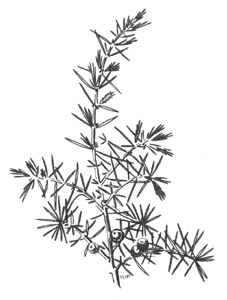Juniperus communis L. (Conifers)
This bush, no taller than a child, is to be found on limy soils throughout the Northern hemisphere. Branches carry numerous small spiky leaves. It is a typical plant for the mediterranean garrigue (brush) landscape, at elevations ranging from 1,500 to 3,000 feet.
 It is sought for its berries. Their color is green the first year and blue the second. Both kinds coexist on a single plant. A volatile oil can be extracted from them. After drying it amounts to 0,3-2,5 % in weight of the fruit. This essential oil has a familiar aroma and taste. It endows alcoholic solutions, such as Dutch genever and British gin, with their characteristic odor and taste. Those drinks were derived from traditional uses, in folk pharmacopeia, as diuretics and as appetite stimulants. Juniper berries and the essential oil both contain also substances with hypoglycemic activity. Their ingestion, from e.g. a decoction of the berries, lowers glucose blood levels. This seems to be due to a decrease in peripheral glucose metabolism.
It is sought for its berries. Their color is green the first year and blue the second. Both kinds coexist on a single plant. A volatile oil can be extracted from them. After drying it amounts to 0,3-2,5 % in weight of the fruit. This essential oil has a familiar aroma and taste. It endows alcoholic solutions, such as Dutch genever and British gin, with their characteristic odor and taste. Those drinks were derived from traditional uses, in folk pharmacopeia, as diuretics and as appetite stimulants. Juniper berries and the essential oil both contain also substances with hypoglycemic activity. Their ingestion, from e.g. a decoction of the berries, lowers glucose blood levels. This seems to be due to a decrease in peripheral glucose metabolism.
Juniper berries find uses in cooking too, from perfuming sauerkraut to heightening the flavor of a bland meat, such as a pork roast. They serve to season a turreen or a pâté, and stuffings for dishes made from small game, such as birds. For such purpose, the berries are crushed in a mortar, with the addition of a pinch of salt and a little oil, to assist in extraction of the sapid principles. Often, a marinade for boar or hare, consists of white wine, with vinegar and spiced with juniper berries. This is how one prepares for instance the coastal Tuscany hare dish known as lepre in dolce e forte .
My adopted city, Liège, prides itself on its emblematic entrée, veal kidneys in the Liège style. They are smothered in butter and, towards the end of the cooking, one adds to the saucepan a little genever and a paste of crushed juniper berries.

